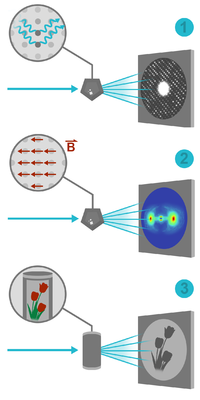Five reasons for using neutrons: Difference between revisions
Jump to navigation
Jump to search

ucph>Tommy No edit summary |
m (1 revision imported) |
(No difference)
| |
Latest revision as of 22:14, 18 February 2020

Figure 1: Illustration of three of the ``five reasons for neutron scattering. 1) shows a diffraction experiment that reveals the positions of the individual atoms in a crystal of the material, 2) shows a small-angle scattering experiment on tiny magnetic particles. From the pattern is can be deduced how large the particles are and which way the magnetic moments point (in this case vertical) (!), 3) shows a transmission (or imaging) experiment, where a rose is revealed inside a metal container, showing the neutrons' ability to penetrate many materials (but not hydrogenous ones).
We will now present some of the assets of neutron scattering. We will focus on cases where neutrons can be preferred to X-rays or where neutrons are needed to complement X-rays. It is commonly agreed in the neutron scattering community that this can be formulated in five general points:
- Energy and wavelength: Thermal neutrons have a wavelength (around 1.8 Å) similar to inter-atomic distances, and an energy (around 25 meV) similar to elementary excitations in solids. One can thus obtain simultaneous information on the structure and dynamics of materials and e.g. measure dispersion relations (energy-wavelength dependence) of excitations in materials.
- Isotopes and light elements: The neutron scattering cross section varies in a seemingly erratic fashion between elements and even between different isotopes of the same element. The scattering cross section is sizable for all elements, and one can thus use neutrons to study light isotopes. In particular, this is important for hydrogen, which is almost invisible to X-rays. With neutrons, the large difference in scattering between usual hydrogen (\(^1\)H) and deuterium, (\(^2\)D) can be used in soft matter and life sciences to change the contrast in the scattering and also "highlight" selected groups within large molecules or aggregates.
- Quantitative experiments: The interaction between neutrons and (most) matter is rather weak, implying that neutrons can probe the bulk of the sample, and not only its surface region. The weak interaction also diminishes higher order effects, such as multiple scattering. Hence, quantitative comparisons between neutron scattering data and theoretical models can be performed to a high precision.
- Transparency: Since neutrons penetrate matter easily, neutron scattering can be performed with samples stored in all sorts of sample environment, such as cryostats, magnets, furnaces or pressure cells. Furthermore, very bulky samples can be studied, up to tens of cm thickness, depending on their elemental composition. The sample is left relatively unharmed by the neutron experiment, although beam experiments should certainly not be performed on living organisms.
- Magnetism: The neutron magnetic moment makes neutrons scatter from magnetic structures or magnetic field gradients. Normal (unpolarized) neutrons are used to learn about the periodicity and magnitude of the magnetic order, while scattering of spin-polarized neutrons can reveal the direction of the atomic magnetic moments. Also. the dynamics of the magnetic moments can be revealed.
In most cases, neutron scattering is performed in combination with other experimental techniques; often with neutron scattering as one of the final techniques to be applied before conclusions are drawn.